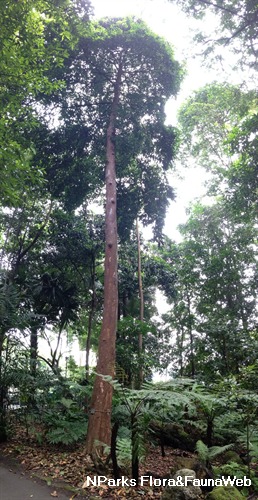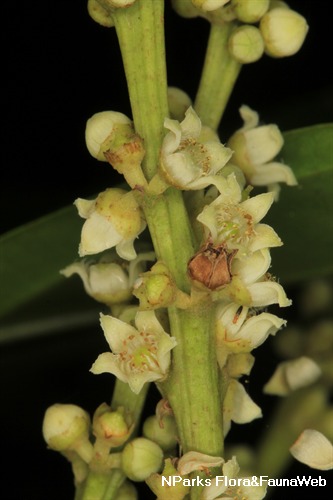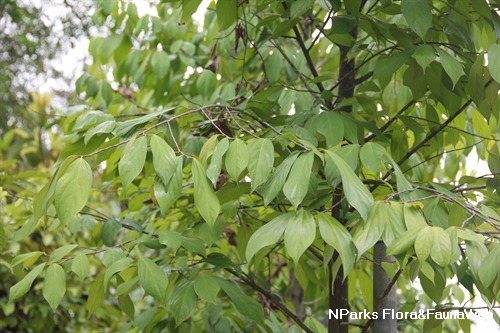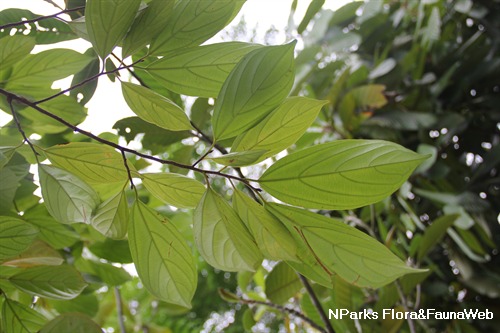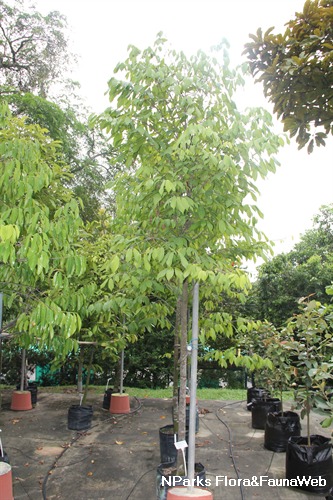
Back
Ochanostachys amentacea Mast.
| Family Name: | Olacaceae |
| Synonyms: | Ochanostachys bancana, Anacolosa bancana |
| Common Name: | Petaling, Tamggal |
Name
Classifications and Characteristics
| Plant Division | Angiosperms (Flowering Seed Plants) |
|---|---|
| Plant Growth Form | Tree |
| Maximum Height | 50 m |
Biogeography
| Native Distribution | Sumatra, Banka, Peninsular Malaysia, Singapore, and Borneo |
|---|---|
| Native Habitat | Terrestrial |
| Preferred Climate Zone | Tropical |
| Local Conservation Status | Native to Singapore (Vulnerable (VU)) |
Description and Ethnobotany
| Growth Form | It is usually a tree up to 30 m tall, rarely reaching 50 m tall. Its grey-brown to brown-red bark is characteristically flaky, exposing the lighter, inner patches, and thus having a mottled appearance. The tree produces white latex. |
|---|---|
| Foliage | Its spirally arranged, stalked leaves have rather leathery to leathery leaf blades that are egg-shaped to elliptic or elliptic-oblong, and about 5–13 by 2.5–7 cm. There are blackish dots present on both the surfaces of the leaf blades. |
| Flowers | Its flowering shoots are simple or branched and about 2–12 cm long. Its flowers are well spaced along the flowering shoots, either solitary or in clusters of 2–3. |
| Fruit | Its fruits are rather round yellow drupes that are pendulous and 1.5–3 cm wide. |
| Habitat | It grows in lowland forests up to 950 m altitude. It occurs locally in Bukit Timah Nature Reserve, Central Catchment Nature Reserve, Changi, Nee Soon Swamp Forest, and Pulau Tekong. |
| Etymology | Greek ochanostachys, shield-handle, and spike, referring to the long and slender flowering spikes; Latin amentacea, having catkins, possibly referring to the plant’s flowering shoots |
| Ethnobotanical Uses | Edible Plant Parts : Edible Fruits Food (Fruit or Vegetable) (Herb or Spice) Others: It is a source of timber. Its fruits are edible. Bathing in a decoction of the bark is used to treat fever and after childbirth. For rheumatic fever, a root paste and other herbs are applied to swollen joints. A leaf bath with the bark of Koompassia and coriander (Coriandrum sativum) seeds is helpful as well. |
Plant Care and Propagation
| Light Preference | Full Sun, Semi-Shade |
|---|---|
| Water Preference | Moderate Water |
| Plant Growth Rate | Moderate |
Foliar
| Mature Foliage Colour(s) | Green |
|---|---|
| Leaf Area Index (LAI) for Green Plot Ratio | 3.0 (Tree - Intermediate Canopy) |
Floral (Angiosperm)
| Flower Colour(s) | Cream / Off-White, Green |
|---|
Fruit, Seed and Spore
| Mature Fruit Colour(s) | Yellow / Golden |
|---|
Image Repository
Others
| Master ID | 1751 |
|---|---|
| Species ID | 3044 |
| Flora Disclaimer | The information in this website has been compiled from reliable sources, such as reference works on medicinal plants. It is not a substitute for medical advice or treatment and NParks does not purport to provide any medical advice. Readers should always consult his/her physician before using or consuming a plant for medicinal purposes. |

